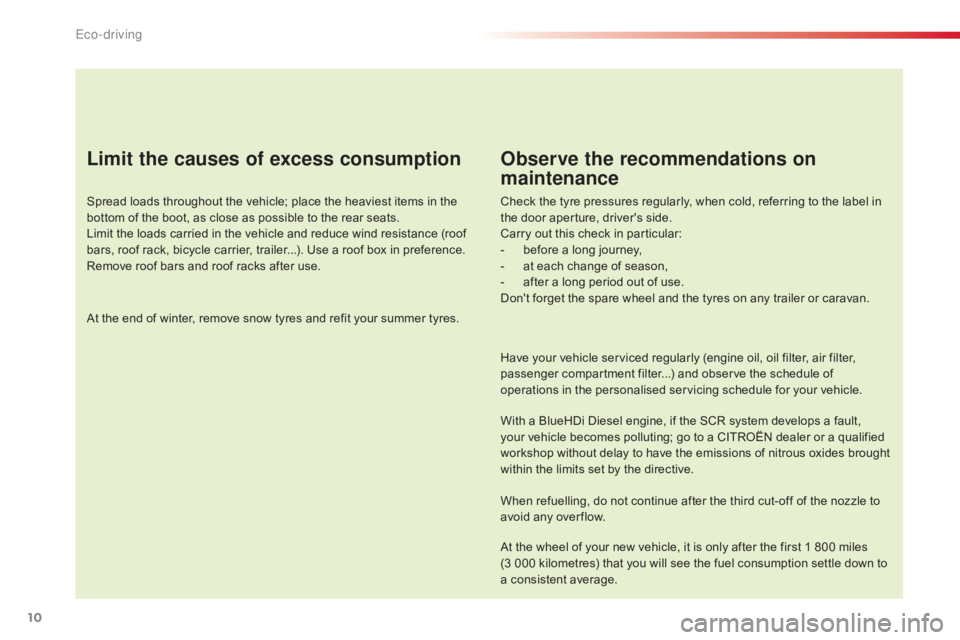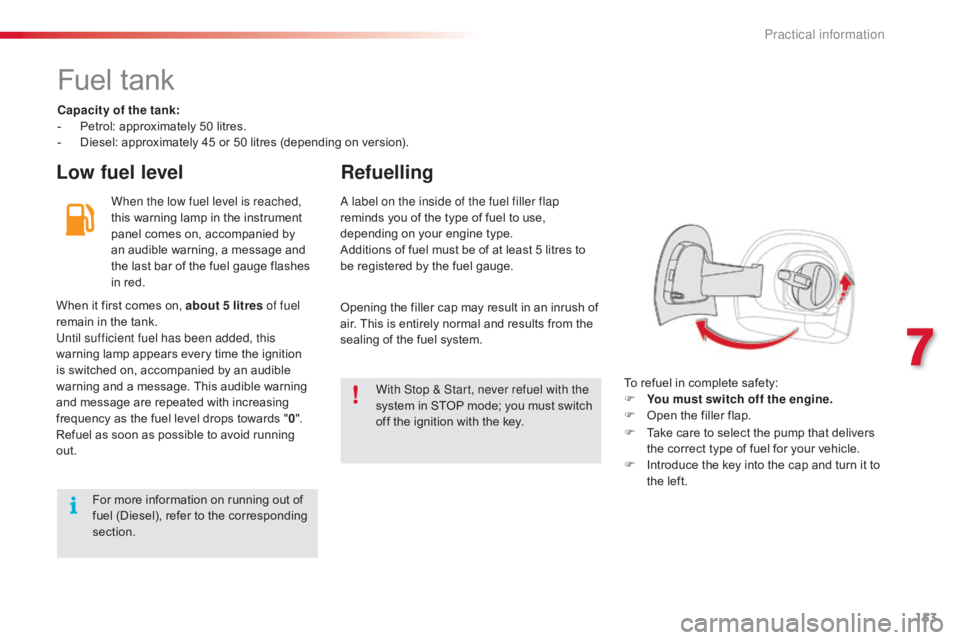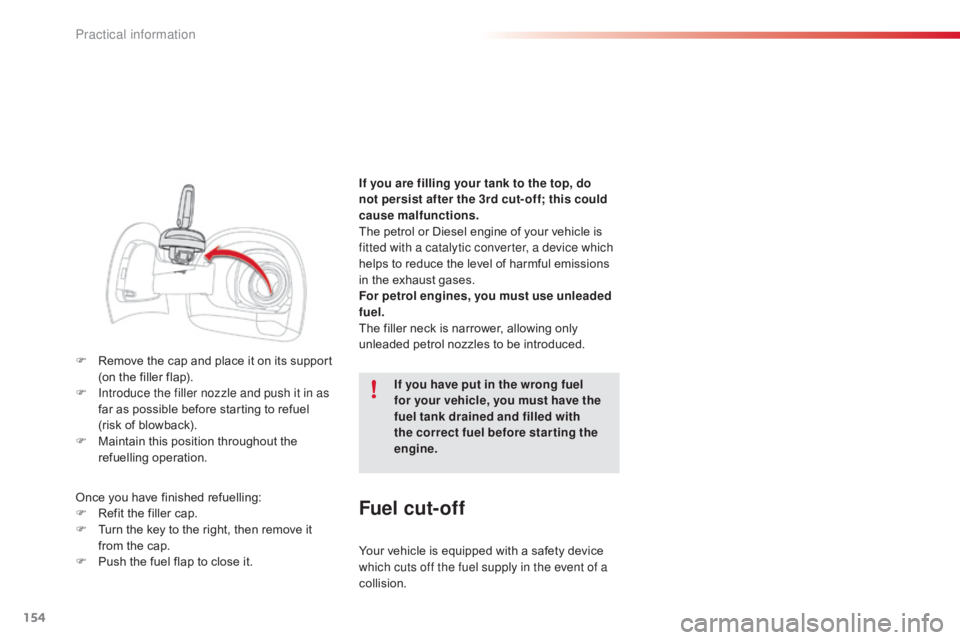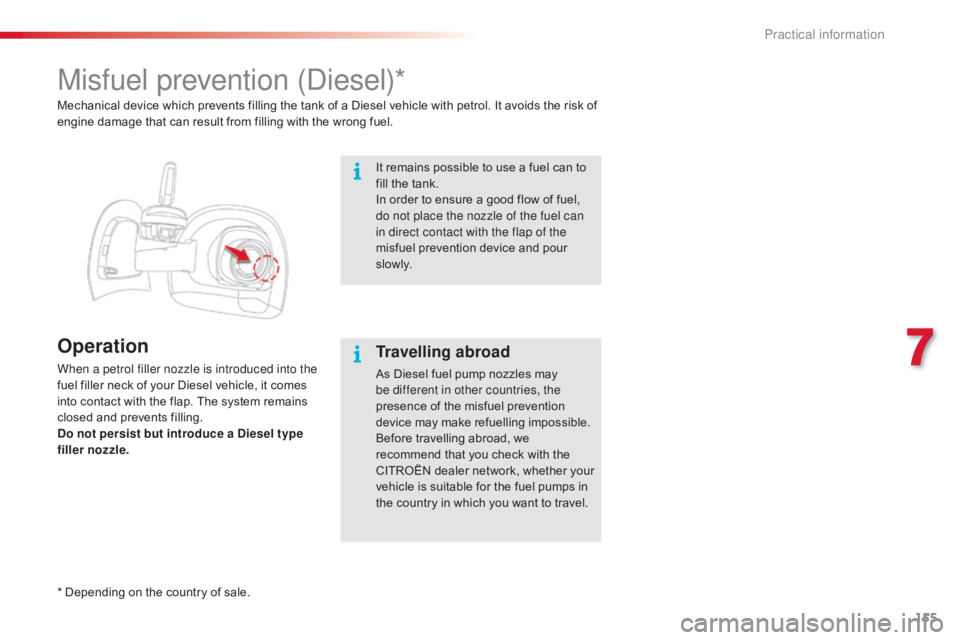refuelling CITROEN C4 2019 Owners Manual
[x] Cancel search | Manufacturer: CITROEN, Model Year: 2019, Model line: C4, Model: CITROEN C4 2019Pages: 317, PDF Size: 9.31 MB
Page 12 of 317

10
C4-cactus_en_Chap00c_eco-conduite_ed01-2016
Limit the causes of excess consumption
Spreadô loadsô throughoutô theô vehicle;ô placeô theô heaviestô itemsô inô theô bottom ô of ô the ô boot, ô as ô close ô as ô possible ô to ô the ô rear ô seats.
Limit
ô the ô loads ô carried ô in ô the ô vehicle ô and ô reduce ô wind ô resistance ô (roof ô
b
ars, ô roof ô rack, ô bicycle ô carrier, ô trailer...). ô Use ô a ô roof ô box ô in ô preference.
Remove
ô roof ô bars ô and ô roof ô racks ô after ô use.
At
ô the ô end ô of ô winter, ô remove ô snow ô tyres ô and ô refit ô your ô summer ô tyres.
Observe the recommendations on
maintenance
Checkô theô tyreô pressuresô regularly,ô whenô cold,ô referringô toô theô labelô inô the ô door ô aperture, ô driver's ô side.
Carry
ô out ô this ô check ô in ô particular:
-
ô
b
efore ô a ô long ô journey,
-
ô
a
t ô each ô change ô of ô season,
-
ô
a
fter ô a ô long ô period ô out ô of ô use.
Don't
ô forget ô the ô spare ô wheel ô and ô the ô tyres ô on ô any ô trailer ô or ô caravan.
Have
ô your ô vehicle ô serviced ô regularly ô (engine ô oil, ô oil ô filter, ô air ô filter, ô
p
assenger ô compartment ô filter...) ô and ô observe ô the ô schedule ô of ô
o
perations ô in ô the ô personalised ô servicing ô schedule ô for ô your ô vehicle.
With
ô a ô BlueHDi ô Diesel ô engine, ô if ô the ô SCR ô system ô develops ô a ô fault, ô
y
our ô vehicle ô becomes ô polluting; ô go ô to ô a ô CITROûN ô dealer ô or ô a ô qualified ô
w
orkshop ô without ô delay ô to ô have ô the ô emissions ô of ô nitrous ô oxides ô brought ô
w
ithin ô the ô limits ô set ô by ô the ô directive.
When
ô refuelling, ô do ô not ô continue ô after ô the ô third ô cut-off ô of ô the ô nozzle ô to ô
a
void ô any ô over flow.
At
ô the ô wheel ô of ô your ô new ô vehicle, ô it ô is ô only ô after ô the ô first ô 1 ô 800 ô miles ô
(3
ô 000 ô kilometres) ô that ô you ô will ô see ô the ô fuel ô consumption ô settle ô down ô to ô
a
ô consistent ô average.
Eco-driving
Page 155 of 317

153
C4-cactus_en_Chap07_info-pratiques_ed01-2016
Fuelô tank
Capacity of the tank:
-ô Pe trol: ô approximately ô 50 ô litres.
-
ô
D
iesel: ô approximately ô 45 ô or ô 50 ô litres ô (depending ô on ô version).
Low fuel levelRefuelling
When the low fuel level is reached,
this
ô warning ô lamp ô in ô the ô instrument ô
p
anel ô comes ô on, ô accompanied ô by ô
a
n ô audible ô warning, ô a ô message ô and ô
t
he ô last ô bar ô of ô the ô fuel ô gauge ô flashes ô
i
n ô red.
To
ô refuel ô in ô complete ô safety:
F
Y
ou must switch off the engine.
F
ô
O
pen ô the ô filler ô flap.
A label on the inside of the fuel filler flap
reminds
ô you ô of ô the ô type ô of ô fuel ô to ô use, ô
d
epending ô on ô your ô engine ô type.
Additions
ô of ô fuel ô must ô be ô of ô at ô least ô 5 ô litres ô to ô
b
e ô registered ô by ô the ô fuel ô gauge.
When
ô
it
ô
first ô comes ô on, ô about 5 litres of fuel
remain
ô
in
ô
the ô tank.
Until sufficient fuel has been added, this
warning
ô
lamp ô appears ô every ô time ô the ô ignition ô
i
s
ô
switched ô on, ô accompanied ô by ô an ô audible ô
w
arning
ô
and ô a ô message. ô This ô audible ô warning ô
a
nd
ô
message ô are ô repeated ô with ô increasing ô
f
requency
ô as ô the ô fuel ô level ô drops ô towards ô "0 ".
Refuel
ô
as
ô soon ô as ô possible ô to ô avoid ô running ô
o
ut. Opening
ô the ô filler ô cap ô may ô result ô in ô an ô inrush ô of ô
a
ir. ô This ô is ô entirely ô normal ô and ô results ô from ô the ô
s
ealing ô of ô the ô fuel ô system.
With Stop & Start, never refuel with the
system
ô in ô STOP ô mode; ô you ô must ô switch ô
o
ff ô the ô ignition ô with ô the ô key.
For
ô more ô information ô on ô running ô out ô of ô
f
uel ô (Diesel), ô refer ô to ô the ô corresponding ô
s
ection. F
ô
T
ake ô care ô to ô select ô the ô pump ô that ô delivers ô
t
he ô correct ô type ô of ô fuel ô for ô your ô vehicle.
F
ô
I
ntroduce ô the ô key ô into ô the ô cap ô and ô turn ô it ô to ô
t
he ô left.
7
Practical information
Page 156 of 317

154
C4-cactus_en_Chap07_info-pratiques_ed01-2016
Fô Removeô the ô cap ô and ô place ô it ô on ô its ô support ô (
on ô the ô filler ô flap).
F
I
ntroduce the filler nozzle and push it in as
far
ô as ô possible ô before ô starting ô to ô refuel ô
(risk
ô of ô blowback).
F
ô
M
aintain ô this ô position ô throughout ô the ô
r
efuelling
ô ope
ration.
Once
ô you ô have ô finished ô refuelling:
F
ô
R
efit ô the ô filler ô cap.
F
ô
T
urn ô the ô key ô to ô the ô right, ô then ô remove ô it ô
f
rom ô the ô cap.
F
ô
P
ush ô the ô fuel ô flap ô to ô close ô it.If you are filling your tank to the top, do
not persist after the 3rd cut- off; this could
cause malfunctions.
The
ô petrol ô or ô Diesel ô engine ô of ô your ô vehicle ô is ô
f
itted with a catalytic converter, a device which
helps ô to ô reduce ô the ô level ô of ô harmful ô emissions ô
i
n ô the ô exhaust ô gases.
For petrol engines, you must use unleaded
fuel.
The ô filler ô neck ô is ô narrower, ô allowing ô only ô
u
nleaded ô petrol ô nozzles ô to ô be ô introduced.
Your ô vehicle ô is ô equipped ô with ô a ô safety ô device ô
w
hich cuts off the fuel supply in the event of a
collision.
Fuel cut- of f
If you have put in the wrong fuel
for your vehicle, you must have the
fuel tank drained and filled with
the correct fuel before star ting the
engine.
Practical information
Page 157 of 317

155
C4-cactus_en_Chap07_info-pratiques_ed01-2016
Misfuel prevention (Diesel)*
Operation
When a petrol filler nozzle is introduced into the
fuelô filler ô neck ô of ô your ô Diesel ô vehicle, ô it ô comes ô
i
nto ô contact ô with ô the ô flap. ô The ô system ô remains ô
c
losed ô and ô prevents ô filling.
Do not persist but introduce a Diesel type
filler nozzle.
*
ô Depending ô on ô the ô country ô of ô sale.
Mechanical
ô device ô which ô prevents ô filling ô the ô tank ô of ô a ô Diesel ô vehicle ô with ô petrol. ô It ô avoids ô the ô risk ô of ô
e
ngine ô damage ô that ô can ô result ô from ô filling ô with ô the ô wrong ô fuel.
It ô remains ô possible ô to ô use ô a ô fuel ô can ô to ô
f
ill ô the ô tank.
In ô order ô to ô ensure ô a ô good ô flow ô of ô fuel, ô
d
o not place the nozzle of the fuel can
in direct contact with the flap of the
misfuel ô prevention ô device ô and ô pour ô
s
l ow l y.Travelling abroad
Asô Dieselô fuelô pumpô nozzlesô mayô b
e different in other countries, the
presence
ô of ô the ô misfuel ô prevention ô
d
evice ô may ô make ô refuelling ô impossible.
Before
ô travelling ô abroad, ô we ô
r
ecommend ô that ô you ô check ô with ô the ô
C
ITROûN ô dealer ô network, ô whether ô your ô
v
ehicle ô is ô suitable ô for ô the ô fuel ô pumps ô in ô
t
he ô country ô in ô which ô you ô want ô to ô travel.
7
Practical information